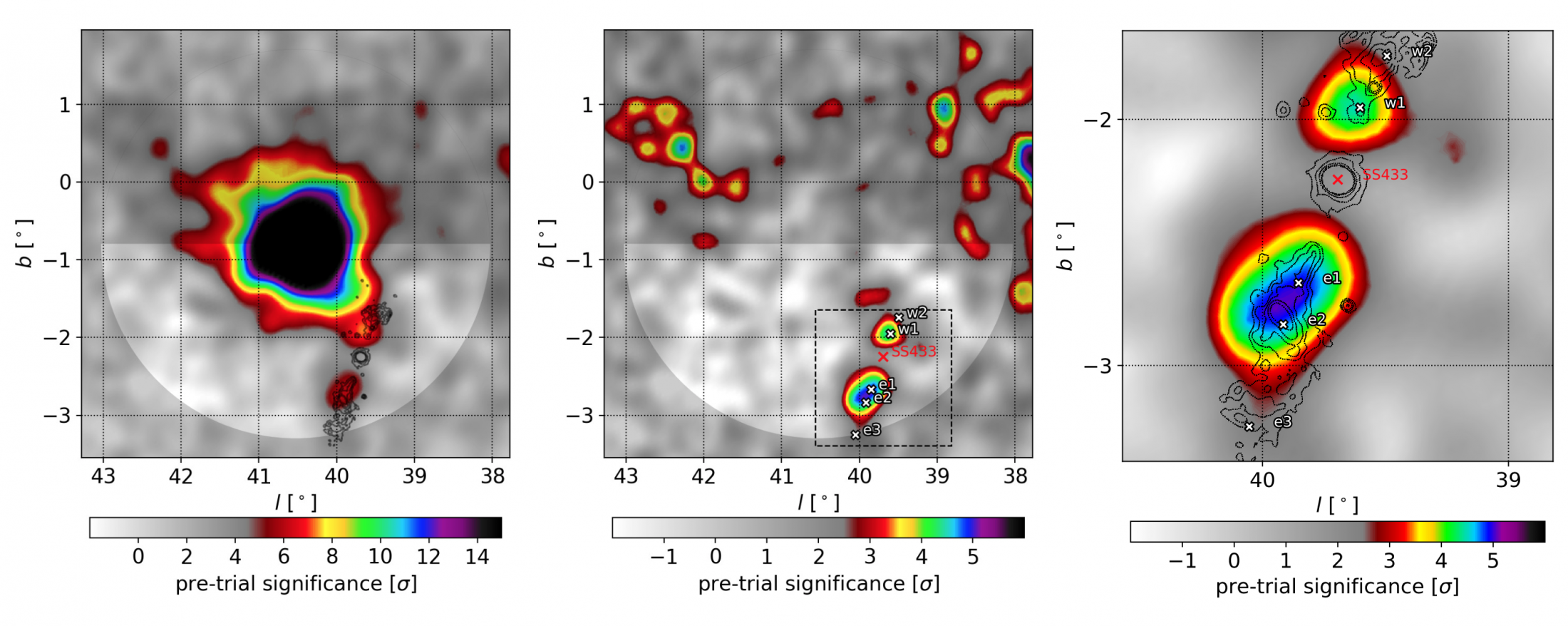For the first time, an international collaboration of scientists has detected extremely high-energy gamma rays, the most powerful type of light, coming from the outermost regions of an unusual star system within our own galaxy. The source is microquasar SS 433, a black hole that gobbles up stuff from a nearby companion star and blasts out powerful jets of material.
The team’s observations, described in the October 4 issue of the journal Nature, represent the most energetic radiation ever detected from a microquasar in our galaxy. And their data strongly suggest that the gamma rays were created by electron acceleration and collisions at the ends of the microquasar’s jets. Scientists think that studying messengers from this microquasar may offer a glimpse into more extreme events happening at the centers of distant galaxies.

SS 433 is one of the most well-known microquasars in our galaxy, where a dozen microquasars are known and only a couple of them appear to emit high-energy gamma rays. In this study, data from the High-Altitude Water Cherenkov Gamma-Ray Observatory (HAWC) were used. HAWC is a detector designed to look at gamma-ray emission coming from astronomical objects such as supernova remnants, rotating dense stars called pulsars, and quasars.
With SS 433’s close proximity—only about fifteen thousand light years away—and orientation, scientists have a rare opportunity to observe extraordinary astrophysics.
“SS 433 is right in our neighborhood, and using HAWC’s unique wide field of view, we were able to resolve both microquasar particle acceleration sites,” says Jordan Goodman, a distinguished university professor at the University of Maryland and U.S. lead investigator and spokesperson for the HAWC collaboration. “By combining our observations with multiwavelength and multimessenger data from other telescopes, we can improve our understanding of particle acceleration in SS 433 and its giant, extragalactic cousins, called quasars.”
Quasars are massive black holes that, rather than feeding on a single star, suck in material from the centers of galaxies. They actively expel radiation, which can be seen from across the universe. But they are so far away that most of the detected quasars have their jets are aimed at Earth—a bit like looking directly into a flashlight. In contrast, SS 433’s jets oriented away from Earth, and HAWC has detected similarly energetic light coming from the microquasar’s side.
The binary star system SS 433 was discovered in 1979, and scientists “very quickly realized that it’s one of the weirdest star systems in the Milky Way,” says Segev BenZvi, a coauthor on the study and a former postdoctoral researcher at WIPAC, where he worked with the late Prof. Stefan Westerhoff. BenZvi is currently an assistant professor of physics at the University of Rochester, where he conducts research on high-energy cosmic rays and gamma rays, trying to understand particle acceleration in supernovae, active galactic nuclei, and other powerful objects in the universe.
Wherever they originate, gamma rays travel in a straight line to their destination. The ones that arrive at Earth collide with molecules in the atmosphere, creating new particles and lower energy gamma rays. Each new particle will also interact with nearby matter and create a shower of particles as the gamma-ray signal cascades toward the ground.

HAWC, located roughly 13,500 feet above sea level near the Sierra Negra volcano in Mexico, is perfectly situated to catch the fast-moving rain of particles. The detector is composed of more than 300 tanks of water, each of which is about 24 feet in diameter (see photo). When the particles strike the water they are moving fast enough to produce a shock wave of blue light, called Cherenkov radiation. Special cameras in the tanks detect this light, allowing scientists to compile the story of the gamma rays’ origin.
The HAWC collaboration examined data taken over 1017 days and saw evidence that gamma rays were coming from the ends of the microquasar’s jets, rather than the central part of the star system. Based on their analysis, the researchers concluded that electrons in the jets attain energies that are about 1000 times higher than can be achieved using earthbound particle accelerators, such as the city-sized Large Hadron Collider. The jet’s electrons collide with the low-energy microwave background radiation that permeates space, resulting in gamma-ray emission. This is a new mechanism for getting high-energy gamma rays out of this kind of system and is different than what scientists have observed when the jets are aimed at Earth.
Until now, no instruments had seen such detailed information about SS 433. HAWC’s excellent sensitivity at the highest observable gamma-ray energies, combined with its wide field of view that allows it to observe the entire overhead sky at all times, enabled the detector to resolve the microquasar’s distinct features.
“SS 433 is an unusual star system, and each year something new has come out about it,” says BenZvi. “This new observation of high-energy gamma rays builds on almost 40 years of measurements of one of the weirdest objects in the Milky Way. Every measurement gives us a different piece of the puzzle, and we hope to use our knowledge to learn about the quasar family as a whole.”
HAWC is an international collaboration consisting of over 120 scientists from 34 universities and national labs in Mexico, the U.S., and Europe. At WIPAC, the team was started by the late Prof. Stefan Westerhoff and is currently led by scientists Thomas Weisgarber and Michael DuVernois who work with postdoctoral researchers Juan Carlos Díaz-Vélez and Josh Wood as well as graduate student James Bourbeau.
Publication reference:
“Very high energy particle acceleration powered by the jets of the microquasar SS 433,” A.U. Abeysekara et al., Nature (2018), DOI: https://doi.org/10.1038/s41586-018-0565-5
For more information about the HAWC Observatory:
https://www.hawc-observatory.org/
Funding:
The HAWC collaboration is funded by the US National Science Foundation (NSF); the US Department of Energy Office of High-Energy Physics; the Laboratory Directed Research and Development program of Los Alamos National Laboratory; Consejo Nacional de Ciencia y Tecnología, México (grants 271051, 232656, 260378, 179588, 239762, 254964, 271737, 258865, 243290, 132197, and 281653) (Cátedras 873, 1563); Laboratorio Nacional HAWC de rayos gamma; L’OREAL Fellowship for Women in Science 2014; Red HAWC, México; DGAPA-UNAM (Dirección General Asuntos del Personal Académico-Universidad Nacional Autónoma de México; grants IG100317, IN111315, IN111716-3, IA102715, 109916, IA102917); VIEP-BUAP (Vicerrectoría de Investigación y Estudios de Posgrado-Benemérita Universidad Autónoma de Puebla); PIFI (Programa Integral de Fortalecimiento Institucional) 2012 and 2013; PRO-FOCIE (Programa de Fortalecimiento de la Calidad en Instituciones Educativas) 2014 and 2015; the University of Wisconsin Alumni Research Foundation; the Institute of Geophysics, Planetary Physics, and Signatures at Los Alamos National Laboratory; Polish Science Centre grant DEC-2014/13/B/ST9/945 and DEC-2017/27/B/ST9/02272; and Coordinación de la Investigación Científica de la Universidad Michoacana. The collaboration thansk S. Delay, L. Díaz, and E. Murrieta for technical support and also acknowledges Richard Mushotzky for providing the spectrum of the XMM-Newton data in the HAWC detection region.
